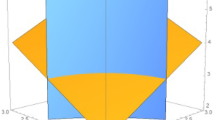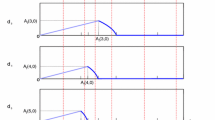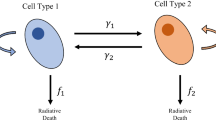Abstract
We address the problem of finding the optimal radiotherapy fractionation scheme, representing the response to radiation of tumour and normal tissues by the LQ model including exponential repopulation and sublethal damage due to incomplete repair. We formulate the nonlinear programming problem of maximizing the overall tumour damage, while keeping the damages to the late and early responding normal tissues within a given admissible level. The optimum is searched over a single week of treatment and its possible structures are identified. In the two simpler but important cases of absence of the incomplete repair term or of prevalent late constraint, we prove the uniqueness of the optimal solution and we characterize it in terms of model parameters. The optimal solution is found to be not necessarily uniform over the week. The theoretical results are confirmed by numerical tests and comparisons with literature fractionation schemes are presented.
Similar content being viewed by others
References
Astrahan M (2008) Some implications of linear-quadratic-linear radiation dose-response with regard to hypofractionation. Med Phys 35: 4161–4172
Bertuzzi A, Bruni C, Fasano A, Gandolfi A, Papa F, Sinisgalli C (2010) Response of tumor spheroids to radiation: modeling and parameter identification. Bull Math Biol 72: 1069–1091
Bertuzzi A, Fasano A, Gandolfi A, Sinisgalli C (2008) Reoxygenation and split-dose response to radiation in a tumour model with Krogh-type vascular geometry. Bull Math Biol 70: 992–1012
Brenner DJ, Hall EJ (1999) Fractionation and protraction for radiotherapy of prostate carcinoma. Int J Radiat Oncol Biol Phys 43: 1095–1101
Brenner DJ, Hlatky LR, Hahnfeldt PJ, Hall EJ, Sachs RK (1995) A convenient extension of the linear-quadratic model to include redistribution and reoxygenation. Int J Radiat Oncol Biol Phys 32: 379–390
Dionysiou DD, Stamatakos GS, Uzunoglu NK, Nikita KS, Marioli A (2004) A four-dimensional simulation model of tumour response to radiotherapy in vivo: parametric validation considering radiosensitivity, genetic profile and fractionation. J Theor Biol 230: 1–20
Düchting W, Ginsberg T, Ulmer W (1995) Modeling of radiogenic responses induced by fractionated irradiation in malignant and normal tissue. Stem Cells 13(Suppl 1): 301–306
Düchting W, Ulmer W, Lehrig R, Ginsberg T, Dedeleit E (1992) Computer simulation and modelling of tumor spheroid growth and their relevance for optimization of fractionated radiotherapy. Strahlenther Onkol 168: 354–360
Fowler JF (1989) The linear-quadratic formula and progress in fractionated radiotherapy. Br J Radiol 62: 679–694
Fowler JF (2007) Is there an optimum overall time for head and neck radiotherapy? A review, with new modelling. Clin Oncol 19: 8–22
Fowler JF (2008) Optimum overall times II: extended modelling for head and neck radiotherapy. Clin Oncol 20: 113–126
Fowler JF (2010) 21 years of biologically effective dose. Br J Radiol 83: 554–568
Fowler JF, Hararia PM, Leborgne F, Leborgne JH (2003) Acute radiation reactions in oral and pharyngeal mucosa: tolerable levels in altered fractionation schedules. Radiother Oncol 69: 161–168
Fowler JF, Ritter MA, Chappel RJ, Brenner DJ (2003) What hypofractionated protocols should be tested for prostate cancer?. Int J Radiat Oncol Biol Phys 56: 1093–1104
Guerrero M, Li XA (2004) Extending the linear-quadratic model for large fraction doses pertinent to stereotactic radiotherapy. Phys Med Biol 49: 4825–4835
Hlatky LR, Hahnfeldt P, Sachs RK (1994) Influence of time-dependent stochastic heterogeneity on the radiation response of a cell population. Math Biosci 122: 201–220
Jones B, Dale RG (1999) Mathematical models of tumour and normal tissue response. Acta Oncol 38: 883–893
Lee EK, Fox T, Crocker I (2006) Simultaneous beam geometry and intensity map optimization in intensity-modulated radiation therapy. Int J Radiat Oncol Biol Phys 64: 301–320
Lu W, Chen M, Chen Q, Ruchala K, Olivera G (2008) Adaptive fractionation therapy: I. Basic concept and strategy. Phys Med Biol 53: 5495–5511
Lu W, Chen M, Chen Q, Ruchala K, Olivera G (2008) Adaptive fractionation therapy: II. Biological effective dose. Phys Med Biol 53: 5513–5525
O’Rourke SFC, McAneney H, Hillen T (2009) Linear quadratic and tumour control probability modelling in external beam radiotherapy. J Math Biol 58: 799–817
Papa F, Sinisgalli C (2011) Optimal solution for a cancer radiotherapy problem with a maximal damage constraint on normal tissues. IASI-CNR Technical Report R, pp 11–20
Pierre DA (1969) Optimization theory with applications. Wiley, New York
Ribba B, Colin T, Schnell S (2006) A multiscale mathematical model of cancer, and its use in analyzing irradiation therapies. Theor Biol Med Model 3: 7. doi:10.1186/1742-4682-3-7
Thames HD (1985) An ‘incomplete-repair’ model for survival after fractionated and continuous irradiations. Int J Radiat Biol 47: 319–339
Turesson I, Thames HD (1989) Repair capacity and kinetics of human skin during fractionated radiotherapy: erythema, desquamation, and telangiectasia after 3 and 5 year’s follow-up. Radiother Oncol 15: 169–188
Williams MV, Denekamp J, Fowler JF (1985) A review of α/β ratios for experimental tumors: implications for clinical studies of altered fractionation. Int J Radiat Oncol Biol Phys 11: 87–96
Wong CS, Hill RP (1998) Experimental radiotherapy. In: Tannock IF, Hill RP (eds) The basic science of oncology. McGraw-Hill, New York, pp 322–349
Yang Y, Xing L (2005) Optimization of radiotherapy dose-time fractionation with consideration of tumor specific biology. Med Phys 32: 3666–3677
Author information
Authors and Affiliations
Corresponding author
Rights and permissions
About this article
Cite this article
Bertuzzi, A., Bruni, C., Papa, F. et al. Optimal solution for a cancer radiotherapy problem. J. Math. Biol. 66, 311–349 (2013). https://doi.org/10.1007/s00285-012-0512-2
Received:
Revised:
Published:
Issue Date:
DOI: https://doi.org/10.1007/s00285-012-0512-2




